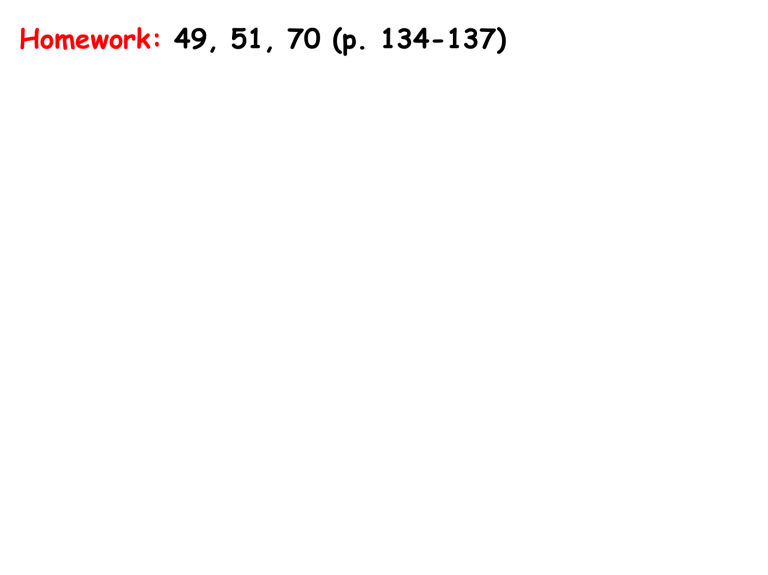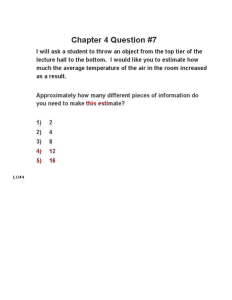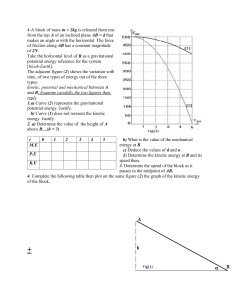
Homework: 49, 51, 70 (p. 134-137) 49. In the figure below, a car is driven at constant speed over a circular hill and then into a circular valley with the same radius. At the top of the hill, the normal force on the driver from the car seat is 0. The driver’s mass is 80.0 kg. What is the magnitude of the normal on the driver from the seat when the car passes through the bottom of the valley? FN At the top of the hill: FN v2 Fcentripetal = Fg - FN = m R 2 v FN = 0 Þ Fg = m R At the bottom of the valley: Fg v2 v2 Fcentripetal = FN - Fg = m Þ FN = m + Fg R R FN = 2Fg = 2mg = 2 ´ 80 ´ 9.8 = 1568 (N) Fg 51. An airplane is flying in a horizontal circle at a speed of 600 km/h. If its wings are tilted at angle q=400 to the horizontal, what is the radius of the circle in which the plane is flying? Assume that the required force is provided entirely by an “aerodynamic lift” that is perpendicular to the wing surface. Animation •According to the Bernoulli’s principle, the aerodynamic lift appears due to the air-stream velocity over the top of the airplane greater than that at the bottom. Fl,y Fl q Fl,x Fl, y = Fg Fl cos q = mg (1) Fl,x is the 2 Fg v centripetal force: Fl, x = m R 2 v Fl sin q = m (2) R v = 600 km/h = 166.7 m/s v2 166.7 2 (1) and (2) Þ R = = » 3379 (m) or 3.38 (km) g tan q 9.8 tan(40) 70. The figure below shows a conical pendulum, in which the bob (the small object at the lower end of the cord) moves in a horizontal circle at constant speed. The cord sweeps out a cone as the bob rotates. The bob has a mass of 0.050 kg, the string has length L=0.90 m and negligible mass, and the bob follows a circular path of circumference 0.94 m. What are (a) the tension in the string and (b) the period of the motion? Animation Ty - Fg = 0 Þ Tsinq = mg Tx: the centripetal force q: the angle between the cord and the horizontal circle. 2 2 v v Tx = m Þ T cos q = m R R R C 0.94 (m) cos q = ; R = = = 0.15 m L 2π 2 ´ 3.14 R q = arccosæç ö÷ = 80.40 L ø è mg Ty T q Tx Fg C T ´ Rcosθ (a) T = = 0.5 (m/s); P = = 1.88 (s) » 0.5 (N) (b) v = m v sinq Part B Laws of Conservation Chapter 3 Work and Mechanical Energy 3.1. Kinetic Energy and Work. Power 3.2. Work-Kinetic Energy Theorem 3.3. Work and Potential Energy 3.4. Conservative and Non-conservative Forces. Conservative Forces and Potential Energy 3.5. Conservation of Mechanical Energy 3.6. Work Done on a System by an External Force. Conservation of Energy What is energy? Energy is the capacity of a system to do work. There are many forms of energy: • Mechanical energy: •Potential energy, stored in a system •Kinetic energy, from the movement of matter • Radiant energy (solar energy) • Thermal energy • Chemical energy (chemical bonds of molecules) • Electrical energy (movement of electrons) • Electromagnetic energy (from X-rays to radio waves) • Nuclear energy Energy can be transformed from one type to another and transferred from one object to another, but the total amount is always the same (the principle of energy conservation). What is energy? Energy is the capacity of a system to do work. There are many forms of energy: • Mechanical energy: •Potential energy, stored in a system •Kinetic energy, from the movement of matter • Radiant energy (solar energy) • Thermal energy • Chemical energy (chemical bonds of molecules) • Electrical energy (movement of electrons) • Electromagnetic energy (from X-rays to radio waves) • Nuclear energy Energy can be transformed from one type to another and transferred from one object to another, but the total amount is always the same (the principle of energy conservation). 3.1. Kinetic Energy and Work. Power 3.1.1. Kinetic Energy and Work Kinetic energy is energy associated with the state of motion of an object. 1 2 K = mv 2 1 joule = 1 J = 1 kg. m2/s2 Work is energy transferred to or from an object by means of a force acting on the object. Energy transferred to the object is positive work and energy transferred from the object is negative work. Unit: joule 3.1.2. Work done by a force A. Work done by a constant force: •To establish an expression for work, we consider a constant force F that accelerates a bead along a wire: Fx = ma x 2 2 v = v 0 + 2a x d 1 1 2 2 Þ mv - mv0 = Fx d 2 2 Therefore, the work W done on the bead by F is: W = Fx d = Fd cosf !! W = F d (work done by a constant force) B. Work done by a general variable force: One-dimensional analysis: •Choose Dx small enough, work done by the force in the jth interval: ΔWj = Fj,avg Dx •The total work: W = å DWj =å Fj,avg Dx W = lim å Fj,avg Dx Dx ®0 xf W = ò F(x)dx (work done by a variable force) xi Three-dimensional analysis: ! ! dW = Fd r = Fx dx + Fy dy + Fz dz rf xf yf zf ri xi yi zi W = ò dW = ò Fx dx + ò Fy dy + ò Fz dz 3.1.3. Power Power is the rate at which work is done. Average power: Instantaneous power: Unit: watt (W) Pavg W = Dt dW P= dt 1 watt = 1 W = 1J/s 1 horsepower = 1 hp = 550 ft.lb/s = 746 W 1 kilowatt - hour = 1kW.h = (10 W)(3600s) = 3.6 ´10 J = 3.6 MJ 3 dW Fcosfdx æ dx ö P= = = Fcosf ç ÷ dt dt è dt ø P = Fvcosf Instantaneous power: !! P = Fv F=constant: 6 3.2. Work-Kinetic Energy Theorem Let DK be the change in the kinetic energy of the bead. ΔK = Kf - Ki = W This can be read as follows: æ change in the kinetic çç è energy of an object or ö æ net work done on ö ÷÷ = çç ÷÷ ø è the object ø K f = Ki + W æ kinetic energy after ö æ kinetic energy ö æ the net ö çç ÷÷ = çç ÷÷ + çç ÷÷ è the net work is done ø è before the net work ø è work done ø Examples: E1. Work done by the gravitational force: W = Fx d = Fd cosf For a rising object, F=1800: W = -mgd For a falling object, F=00: Kf = Ki = 0 Þ W = + mgd Work done in lifting and lowering an object Gravity and an applied force acting on the object: ΔK = K f - K i = Wa + Wg where Wa is the work done by the applied force; Wg is the work done by the gravitational force. If initial and final velocities are zero: Kf = Ki = 0 Þ ΔK = 0 Þ Wa = - Wg Wa = -mgd cosf E2. Work done by a spring force: The spring force is computed by: ! ! Fs = -kd (Hooke' s law) k: the spring constant (or force constant) Is an x axis is parallel to the length of the spring: Fx = -kx (Hooke's law) èA spring force is a variable force F=F(x) To find the work done by the spring force, We have to make assumptions: (1) the spring is massless; (2) It is an ideal spring (it exactly obeys Hooke’s law). ! ! Ws = lim å FxjΔx = lim å FxjΔx cos q = lim å - FxjΔx Dx®0 Dx®0 Dx®0 Note: q = 1800 and Fxj is the magnitude of the spring force Ws = òxx f - Fx dx = òxx f - kxdx i i 1 2 1 2 Ws = kx i - kx f 2 2 1 2 If x i = 0, x f = x : Ws = - kx 2 Work done by an applied force: ΔK = K f - K i = Wa + Ws If the block is stationary before and after the displacement, DK=0: Wa = -Ws Homework: 1, 2, 8, 15, 24, 26, 29, 36, 43 (p. 159-163) Chapter 1: Review (All sections of Chapter 1, 2) Motion in one dimension: To describe motion, we need to measure: + Displacement: Dx = xt – x0 (measured in m or cm) + Time interval: Dt = t – t0 (measured in s) Average velocity: total distance Average speed: s avg = Δt Δx(t) dx(t) = Instantaneous velocity: v(t) = lim Δt ®0 Δt dt Δv v 2 - v1 = Average acceleration: a avg = Δt t 2 - t1 Instantaneous acceleration: dv(t) d 2 x a(t) = = 2 dt dt Two basic equations for constant acceleration: For freely falling objects: Motion in two dimensions: a = g = 9.8 (m/s 2 ) Projectile motion: • Ox: Horizontal motion (no acceleration): v x = v0cosθ0 = constant x = x 0 + v0 cosθ0 t • Oy: Vertical motion (free fall) v y = v0sinθ 0 - gt 1 2 y = y 0 + v 0 sinθ 0 t - gt 2 •Horizontal range: R= 2 v0 g sin2θ 0 Uniform Circular Motion: The particle is accelerating with a centripetal acceleration: 2 v a= r Where r is the radius of the circle v the speed of the particle 2pr T= v (T: period) Relative Velocity and Relative Acceleration: v PA = v PB + v BA ! ! ! v PA = v PB + v BA Chapter 2: Newton’s Laws n ! ! F = 0 or å Fi = 0 i =1 ! ! Fnet = ma ! ! FBC = - FCB Some particular forces: gravitational, normal, tension and frictional forces Friction and Properties of Friction: f s,max = µ s FN f k = µ k FN µ s is the coefficient of static friction µ k is the coefficient of kinetic friction Uniform Circular Motion and Non-uniform Circular Motion: • Uniform circular motion: • Non-uniform circular motion:



